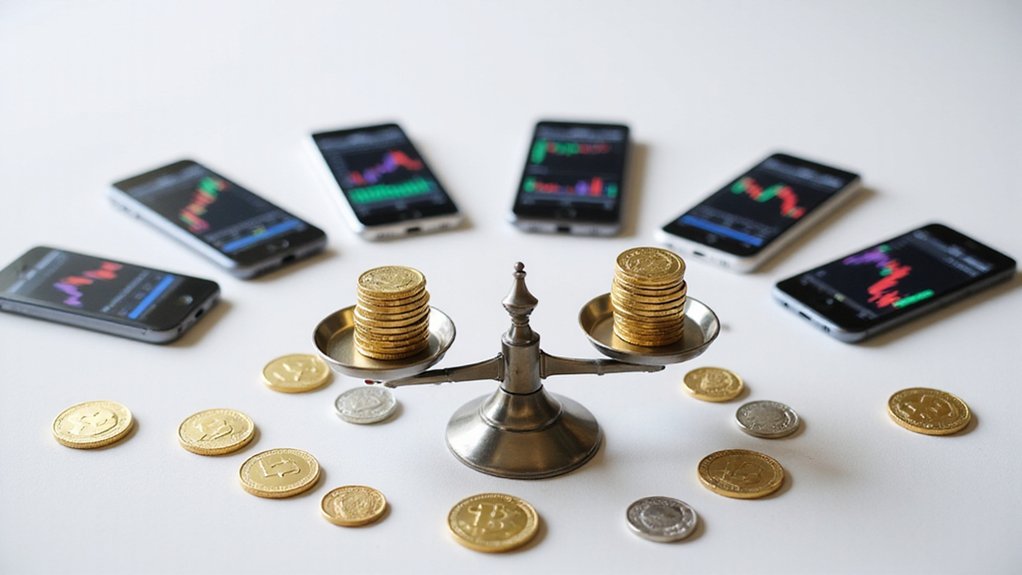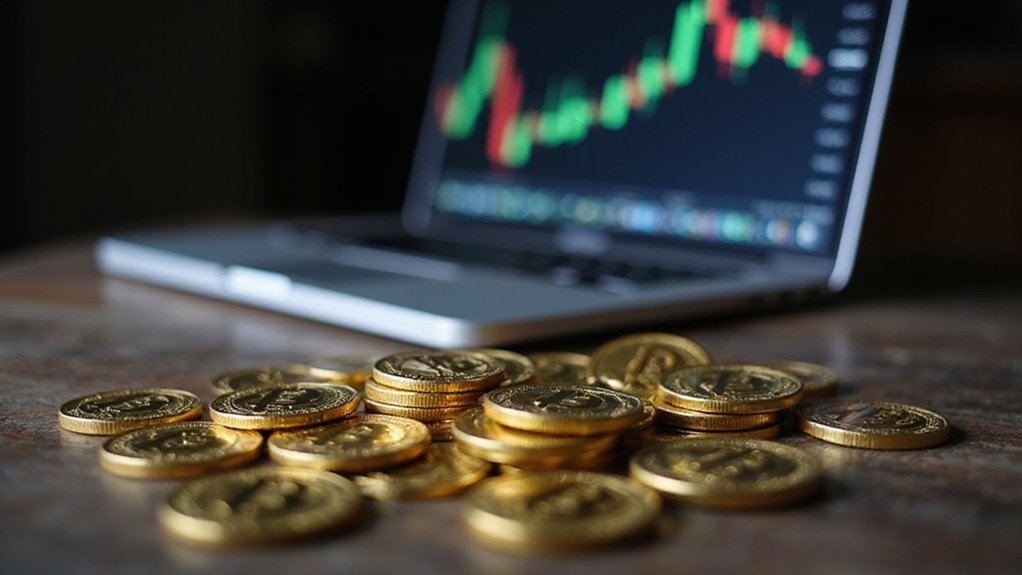Kraken, Binance, and MEXC form the cost-effective trinity, with Kraken’s volume-based tiers reducing fees dramatically for active traders, while Binance offers competitive rates across extensive trading pairs. Paradoxically, riskier derivatives often cost less than spot trading—OKX charges 0.02% maker fees on futures versus 0.08% on spot trades. Premium platforms like Coinbase justify higher fees through regulatory compliance and user-friendly interfaces, though frequent traders pay dearly for such convenience. Strategic platform selection ultimately determines profitability margins across the entire trading ecosystem.

The cryptocurrency exchange landscape presents traders with a bewildering array of fee structures that can make the difference between profitable trading and slowly bleeding capital through death by a thousand cuts.
While marketing departments trumpet “competitive rates,” the reality proves more nuanced—fees vary dramatically across platforms, trading activities, and user tiers, creating a labyrinthine system that rewards the informed and punishes the casual.
Kraken, Binance, and MEXC consistently emerge as the triumvirate of cost-effectiveness, though each excels in different arenas.
These three exchanges form the holy trinity of affordable trading, each reigning supreme in its own specialized domain.
Kraken particularly appeals to experienced traders who appreciate its straightforward approach to fee reduction through volume-based tiers.
Binance offers competitive rates across its extensive trading pairs (assuming one can navigate its increasingly complex ecosystem), while MEXC sweetens the deal with referral bonuses that border on aggressive customer acquisition.
The fee taxonomy reveals telling disparities.
Spot trading typically involves maker and taker fees—OKX charges 0.08% and 0.1% respectively—while futures trading often offers more palatable rates, with maker fees dropping to 0.02%.
This creates the amusing paradox where the riskier derivative instruments cost less to trade than their underlying assets.
Liquidity providers who supply assets to these exchanges earn rewards through the very trading fees that platforms collect, creating an ecosystem where fee structures must balance trader costs with provider incentives.
Coinbase and Gemini occupy the premium segment, justifying higher fees through user-friendly interfaces and regulatory compliance.
Gemini particularly stands out with its zero minimum deposit requirement, making it accessible to traders regardless of their initial capital.
Whether this trade-off merits the additional cost depends largely on one’s tolerance for complexity versus convenience—a calculation that becomes increasingly expensive for frequent traders.
Strategic fee minimization requires understanding the peculiar incentive structures exchanges employ.
Holding native tokens like OKB can reduce fees, creating a curious loyalty program where traders become involuntary stakeholders in their chosen platform’s success.
Volume-based tiers reward the wealthy with lower rates, while limit orders typically cost less than market orders—rewarding patience in an industry that celebrates speed.
Market conditions and regulatory compliance costs influence fee structures, meaning today’s competitive rates may become tomorrow’s premium pricing.
The proliferation of VIP programs for high-value traders creates a two-tiered system where institutional participants enjoy advantages that retail traders can only observe from afar.
Ultimately, exchange selection requires balancing fee structures against trading frequency, volume, and risk tolerance—a decision that increasingly determines profitability margins.
Frequently Asked Questions
Do Exchange Fees Change During High Market Volatility Periods?
Exchange fees typically remain static during volatile periods, as platforms prioritize predictable fee structures over dynamic pricing models.
However, traders face increased costs through widened bid-ask spreads and elevated blockchain network fees—particularly for withdrawals—as congestion spikes during market chaos.
While explicit trading fees stay constant, the total cost of trading rises through slippage, slower execution, and network surcharges that exchanges cannot control.
Are There Hidden Fees Not Disclosed in the Standard Fee Structure?
Several undisclosed costs lurk beneath standard fee schedules.
Bid-ask spreads—particularly wide during volatility or with obscure altcoins—function as stealth fees. Slippage on large market orders can devastate budgets beyond advertised rates.
Wire transfer fees, network congestion charges, and withdrawal costs often surprise newcomers. Some platforms impose account maintenance fees (because apparently holding your money requires compensation).
Smart traders scrutinize fine print, recognizing that “competitive fees” rarely encompass the full cost spectrum.
Can I Negotiate Lower Fees Based on My Trading Volume?
Yes, traders can absolutely negotiate lower fees based on trading volume, though the process varies considerably across platforms.
Most exchanges employ tiered fee structures that automatically reduce costs as 30-day volumes increase, while others like bitFlyer explicitly offer negotiation opportunities.
Institutional clients and high-volume traders often secure customized pricing arrangements—because apparently, moving millions warrants personal attention from exchanges suddenly willing to accommodate.
Do Fees Differ Between Mobile App and Desktop Platform Trading?
Trading fees remain stubbornly consistent across mobile and desktop platforms—a rare instance of exchange fairness that borders on shocking.
Major platforms like Crypto.com and Coinbase maintain identical fee structures (typically 0.075% maker/taker rates) regardless of device preference.
The determinant remains trading volume and account tier, not whether one trades from a phone while commuting or desktop while pretending to work from home.
Are There Additional Fees for Using Credit Cards Versus Bank Transfers?
Credit cards invariably carry substantially higher fees than bank transfers across crypto exchanges—a pricing structure that reflects payment processors’ risk assessments and interchange costs.
While Kraken charges a hefty 3.37% for credit card transactions, bank transfers typically incur minimal or zero fees.
This disparity stems from credit cards’ chargeback risks and processing complexities, making bank transfers the economically rational choice for cost-conscious traders seeking fee optimization.









